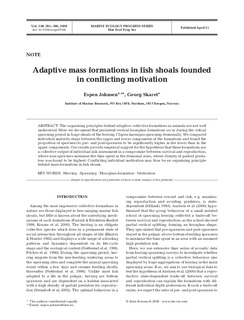| dc.contributor.author | Johnsen, Espen | |
| dc.contributor.author | Skaret, Georg | |
| dc.date.accessioned | 2008-07-17T12:57:05Z | |
| dc.date.available | 2012-05-05 | |
| dc.date.issued | 2008-04-21 | |
| dc.identifier.issn | 0171-8630 | |
| dc.identifier.issn | 1616-1599 | |
| dc.identifier.uri | http://hdl.handle.net/11250/108126 | |
| dc.description.abstract | The organising principles behind adaptive collective formations in animals are not well understood. Here we document that persistent vertical hourglass formations occur during the critical spawning period in huge shoals of the herring Clupea harengus spawning demersally. We compared individual maturity stage between the upper and lower components of the formations and found the proportion of spawners to pre- and post-spawners to be significantly higher in the lower than in the upper components. Our results provide empirical support for the hypothesis that these formations are a collective output of individual risk assessment in a compromise between survival and reproduction, where non-spawners minimise the time spent in the demersal zone, where density of gadoid predators was found to be highest. Conflicting individual motivation may thus be an organising principle behind mass formations in fish shoals. | en |
| dc.format.extent | 517593 bytes | |
| dc.format.mimetype | application/pdf | |
| dc.language.iso | eng | en |
| dc.publisher | Inter-Research | en |
| dc.title | Adaptive mass formations in fish shoals founded in conflicting motivation | en |
| dc.type | Journal article | en |
| dc.type | Peer reviewed | en |
| dc.source.pagenumber | 295-300 | en |
| dc.source.volume | 358 | en |
| dc.source.journal | Marine Ecology Progress Series | en |
| dc.identifier.doi | http://dx.doi.org/10.3354/meps07326 | |
